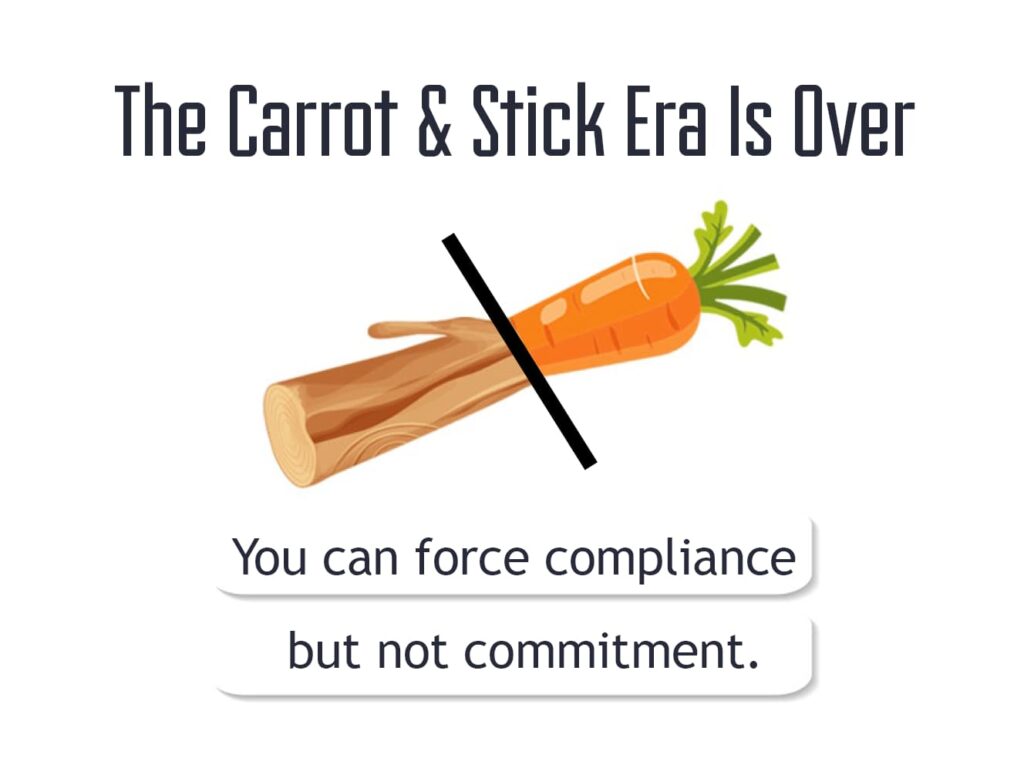Many leaders still rely on the carrot and stick approach: rewards for compliance, punishment for failure. It’s a system as old as leadership itself. And, to an extent, it works—people respond to fear and incentives. But here’s the problem: it doesn’t lead to peak performance, and it doesn’t improve relationships. Most importantly, it doesn’t build a workplace where people genuinely want to excel.
The neuroscience behind motivation tells us that peak performance requires more than external control—it requires an environment where employees feel engaged, challenged, and focused. The best leaders don’t just extract results from their teams; they create the conditions where great results happen naturally.

The Problem: Carrot and Stick Is a Short-Term Fix
At its core, the carrot-and-stick model assumes that people are externally motivated—that they need either a reward to chase or a punishment to avoid. This might work in simple, mechanical tasks, but for knowledge work, problem-solving, and innovation, it falls short. Here’s why:
The Stick: Fear Undermines Performance
Using threats or punishments triggers cortisol, the body’s stress hormone. While a little stress can help short-term focus, sustained fear-based leadership leads to:
- Weakened Creativity – Stress inhibits the brain’s ability to generate new ideas and solutions.
- Distorted Perception – Fear shifts focus to immediate survival, reducing the likelihood of seeing the positive in a situation.
- Lower Collaboration – When people feel threatened, they withdraw or become defensive rather than working together.
- Compromised Cognition – High cortisol impairs memory, learning, and decision-making abilities.
Leaders who rely on fear may get compliance, but they lose trust, collaboration, and discretionary effort.
The Carrot: External Rewards Have Limits
While rewards can motivate in the short term, they don’t sustain performance over time. Research shows that once an extrinsic reward (bonus, promotion, prize) becomes expected, its power diminishes. This is because:
- Dopamine spikes from external rewards are short-lived – They provide temporary excitement but don’t create lasting motivation.
- They don’t drive intrinsic engagement – People work for the reward, not because they care about the work itself.
- They can create unintended consequences – Employees may cut ethical corners or prioritize short-term wins over long-term success.
However, dopamine from intrinsic motivation and purposeful engagement lasts longer. Activities that are meaningful, enjoyable, and aligned with personal values or growth produce more sustained dopamine release.
The Alternative: Leadership Happens in a Relationship
Real leadership doesn’t happen in a vacuum—it happens in a relationship. People don’t do their best work for rules, policies, or incentives. They do it for people they trust, leaders who create an environment where they can thrive.
Peak performance comes from a balance of three key neurotransmitters:
- Dopamine (Enjoyment) – Fuels motivation and engagement.
- Noradrenaline (Challenge) – Drives focus when tasks are appropriately difficult.
- Acetylcholine (Concentration) – Helps with deep focus and learning.
Unlike the carrot-and-stick model, which only provides momentary spikes of motivation, these neurotransmitters create a sustainable drive when leaders cultivate the right environment.
Great leaders don’t rely on punishment or transactional rewards. Instead, they focus on:
- Mutual Trust – Employees need psychological safety to take risks and innovate. Trust isn’t built through fear or manipulation—it’s built through consistency, honesty, and fairness.
- Opportunities for Growth – People are most motivated when they feel they’re progressing. Leaders must provide challenging but achievable tasks that trigger noradrenaline in a positive way.
- Predictable Environment – A stable, transparent workplace minimizes unnecessary stress, allowing employees to focus on peak performance.
These three elements form the foundation of Relationship-Based Leadership (RBL)—a leadership approach where success isn’t extracted from employees but cultivated through them.
Final Thought: Leadership Is About Making People Want to Win
You can force compliance, but you can’t force passion. The best leaders don’t manipulate people into working hard; they create an environment where people want to work hard.
Carrots and sticks may get short-term obedience, but they won’t inspire the kind of performance that truly transforms organizations. The future of leadership isn’t about fear or bribery—it’s about relationships, trust, and unlocking the best in people.
Because when people feel valued, challenged, and trusted, they don’t need a carrot or a stick to perform—they choose to excel.

